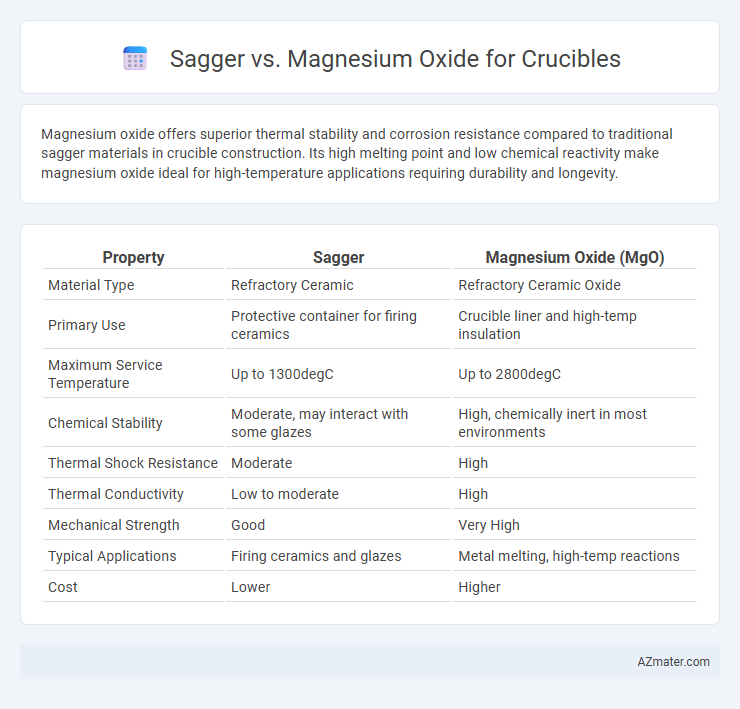Magnesium oxide offers superior thermal stability and corrosion resistance compared to traditional sagger materials in crucible construction. Its high melting point and low chemical reactivity make magnesium oxide ideal for high-temperature applications requiring durability and longevity.
Table of Comparison
| Property | Sagger | Magnesium Oxide (MgO) |
|---|---|---|
| Material Type | Refractory Ceramic | Refractory Ceramic Oxide |
| Primary Use | Protective container for firing ceramics | Crucible liner and high-temp insulation |
| Maximum Service Temperature | Up to 1300degC | Up to 2800degC |
| Chemical Stability | Moderate, may interact with some glazes | High, chemically inert in most environments |
| Thermal Shock Resistance | Moderate | High |
| Thermal Conductivity | Low to moderate | High |
| Mechanical Strength | Good | Very High |
| Typical Applications | Firing ceramics and glazes | Metal melting, high-temp reactions |
| Cost | Lower | Higher |
Introduction to Sagger and Magnesium Oxide Crucibles
Sagger crucibles are protective containers used to shield metal or ceramic materials from direct flame or contamination during high-temperature processes, ensuring purity and controlled reactions. Magnesium oxide crucibles, composed primarily of magnesia (MgO), offer excellent thermal resistance, chemical inertness, and high melting points, making them ideal for containing materials in sagger applications. Combining sagger techniques with magnesium oxide crucibles enhances durability and stability in demanding metallurgical and ceramic firing environments.
Material Composition: Sagger vs Magnesium Oxide
Sagger is typically made from clay or alumina-based ceramics designed to protect crucibles during firing by preventing direct contact with flames and contaminants. Magnesium oxide (MgO), a refractory material with high thermal stability and excellent insulation properties, is often used as a crucible lining or as a component in high-temperature applications. While saggers provide a protective barrier based on ceramic compositions, magnesium oxide offers superior heat resistance and chemical inertness, making it ideal for crucibles exposed to extreme temperatures and reactive environments.
Thermal Stability and Heat Resistance
Sagger and magnesium oxide both exhibit high thermal stability and heat resistance, essential for crucible applications in high-temperature environments. Magnesium oxide offers superior refractoriness with a melting point around 2852degC and excellent resistance to thermal shock, making it ideal for prolonged exposure to extreme heat. Sagger, typically made from fired clay or ceramic materials, has adequate thermal stability but generally lower maximum service temperatures and heat resistance compared to magnesium oxide-based crucibles.
Chemical Reactivity and Compatibility
Sagger materials like ceramic or alumina provide superior chemical stability and low reactivity when used with crucibles, preventing contamination during high-temperature processes. Magnesium oxide (MgO) offers excellent thermal resistance and chemical inertness, making it highly compatible with a wide range of molten metals and slags. However, MgO can react with certain acidic slags, leading to partial dissolution, whereas sagger composition is typically engineered to resist specific chemical environments for optimal crucible performance.
Mechanical Strength and Durability
Sagger ceramics typically offer enhanced mechanical strength due to their composite structure, which improves resistance to thermal shock and mechanical impact compared to pure magnesium oxide crucibles. Magnesium oxide crucibles excel in thermal stability and corrosion resistance but may exhibit lower mechanical strength, making them more susceptible to cracking under rapid temperature changes. For applications demanding high durability under intense thermal cycling, sagger-enhanced materials provide superior performance over conventional magnesium oxide.
Cost and Availability Comparison
Magnesium oxide crucibles typically offer a lower cost per unit and widespread availability due to established industrial production and abundant raw materials. Sagger crucibles, often made from specialized refractory materials, tend to be more expensive and less readily available, particularly in bulk quantities. Cost efficiency and lead time considerations usually make magnesium oxide the preferred choice for high-volume or budget-sensitive applications.
Applications in Laboratory and Industry
Saggers offer customizable protection for crucibles in laboratory and industrial high-temperature processes, preventing contamination during material synthesis and heat treatment. Magnesium oxide crucibles provide excellent thermal shock resistance and chemical inertness, ideal for melting metals, ceramics, and conducting high-temperature chemical reactions. Combining saggers with magnesium oxide crucibles enhances durability and insulation, optimizing sample purity and process efficiency in research and manufacturing applications.
Lifespan and Maintenance Requirements
Sagger crucibles made from high-quality ceramics offer enhanced lifespan compared to magnesium oxide crucibles, which tend to degrade faster under extreme thermal cycling. Magnesium oxide crucibles require more frequent maintenance due to their susceptibility to cracking and surface pitting during prolonged use at high temperatures. The superior thermal shock resistance and chemical stability of sagger materials reduce downtime and replacement costs in industrial applications.
Environmental and Safety Considerations
Magnesium oxide is preferred over sagger materials for crucibles due to its lower toxicity, chemical stability, and resistance to thermal shock, which reduces the risk of hazardous breakdown and improves workplace safety. Sagger materials, often composed of clay or ceramic, may release harmful dust and fumes during heating, posing environmental concerns and respiratory hazards to operators. Magnesium oxide crucibles also contribute to less environmental contamination since they do not degrade into harmful byproducts under extreme temperatures, making them a safer and more eco-friendly choice for high-temperature processes.
Choosing the Best Crucible Material for Your Needs
Sagger and magnesium oxide each offer distinct advantages as crucible materials; saggers provide excellent containment for reactive substances, reducing contamination during high-temperature processes. Magnesium oxide crucibles boast superior thermal shock resistance and high melting points around 2852degC, making them ideal for applications involving extreme heat and corrosive environments. Selecting the best crucible depends on balancing factors such as chemical compatibility, thermal properties, and specific laboratory or industrial requirements.

Infographic: Sagger vs Magnesium Oxide for Crucible
 azmater.com
azmater.com